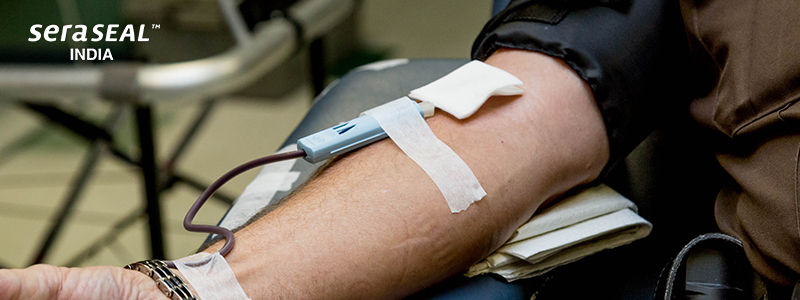70% of your body is water, whereas blarticle in Business Linesood consists of 10% of the adult’s weight. And this 10% plays a crucial role during an accident or trauma. A successful blood transfusion can be the thin line separating life and death. First-hand responders have saved millions of lives with blood transfusion. Therefore, it has become an inevitable part of healthcare.
The need for blood transfusions
Death can, unfortunately, occur on the road or in operation theaters under any circumstance. But one product can hopefully save millions of lives. As estimated in 2018, 2 million people died due to hemorrhage worldwide.
Surgeries
If the patient has a tumor, it can be surgically removed, a defective liver or kidney can be replaced with a fully functioning one, by means of a transplant. Whereas blood loss is inevitable in these surgeries, it is a surgeon’s endeavor to minimize blood loss.
Postpartum hemorrhages
Minimum blood loss is the criteria for a successful surgery. 1-5% of females suffer from postpartum hemorrhage, which can be avoided. These life-givers need a lifesaver too.
Accidents and trauma cases
According to International Business Times, India ranks first in the number of road accident deaths across the world. An article by Times Of India states that around 40% of road accident victims die due to excessive bleeding before reaching hospitals. It is therefore important that the leading cause of death- blood loss, can be tackled efficiently as increasing emergency cases have urged various medical and surgical innovations. And the revolutionary inventions have saved lives and improved life expectancy and quality. So the question arises, what are these inventions? And how blood loss during hemorrhages can be minimized?
FIRST AID EMERGENCY KIT
As stated by healthline.com, Five minutes is enough for a person to bleed to death. So the actions the bystanders take during the golden hour before the emergency personnel arrives can make a huge difference. The first 60 minutes after the trauma is the most crucial as it determines the end outcome and also reduces recovery time.
Challenge faced:
Nowhere, the challenge faced is the limitation of time. The first responders or the emergency responders might sometimes take a little longer than expected to come to the rescue. It has been observed that in mass casualty events, people have died from blood loss, despite non-fatal wounds. In such cases, the new addition to your first aid emergency kit is SeraSeal™ . Brought to India by Swasth Kare, SeraSeal™ is the World’s First and Only Primary Hemostatic Agent. It stops bleeding, not in hours, not minutes, but in seconds. Other hemostatic agents might take a long to mix, prepare and apply to the wound, which can be time-consuming. And sparing even seconds comes at the expense of the patient’s life. When seconds count, SeraSeal™ is the savior.
BLOOD TRANSFUSION
Blood transfusion involves the use of new blood to replace the spilled or lost blood in the patient’s body. The blood loss could be due to trauma or surgery, accident, or injury. Fresh blood is made available from blood banks or a blood donor. In India, there are around 11 million blood donations every year, as stated by an article in Business Lines, The Hindu.
Did you know? Just 1 donation can save up to 3 lives, according to livemint.com, a trusted e-paper.
Challenges faced:
Blood transfusion not only saves lives but also improves health. But there are certain limitations to it as well.
Timely access:
In the case of Trauma, accident injuries need to be addressed as quickly as possible. There could be various scenarios that may lead to the patient’s untimely death. One of them is the help not arriving on time. The patient may die. Blood transfusion is a complex process, where the patient might be saved, but it still would hamper their recovery time, as a significant amount of blood would already be lost.
Safe and adequate blood:
The risk of viruses being transmitted to the patient from the donor or the donated blood is less, but not zero. HIV, hepatitis B, hepatitis C, and syphilis are viruses that the patient may contract.
Availability:
According to WHO, the record of blood donations worldwide is about 118.4 million. But in the worst-case scenario, there could be a shortage of blood type in the banks.
How can SeraSeal™ help overcome all these challenges?
SeraSeal™ can be the one true help in a time of crisis. The advantages of a revolutionary hemostatic agent like SeraSeal™ being the new addition to the Emergency kit are:
- Stops bleeding in Seconds
- No preparation is needed
- Ready to use
- Has multiple application systems
- It can be used outside the hospital setting
A stitch in time saves nine. SeraSeal™ applied on time saves lives.
To know more about this medical innovation, contact us today!
Reference
- https://www.who.int/news-room/fact-sheets/detail/blood-safety-and-availability#:~:text=About%20118.4%20million%20blood%20donations,total%20of%20106%20million%20donations
- https://www.ibtimes.co.in/india-ranks-third-highest-road-accidents-globally-
tn-tops-list-records-most-deaths-details-839204 - https://timesofindia.indiatimes.com/city/hyderabad/40-road-accident-victim
s-in-2018-died-due-to-excessive-loss-of-blood/articleshow/68039860.cms - https://www.thehindubusinessline.com/specials/pulse/voluntary-blood-donation-by-2020-still-a-gap-to-be-bridged/article30705752.ece
- https://www.livemint.com/Leisure/FHDqQPwT7jKaqLZ58nmXMP/How-to-s
ave-three-lives-in-a-day.html




